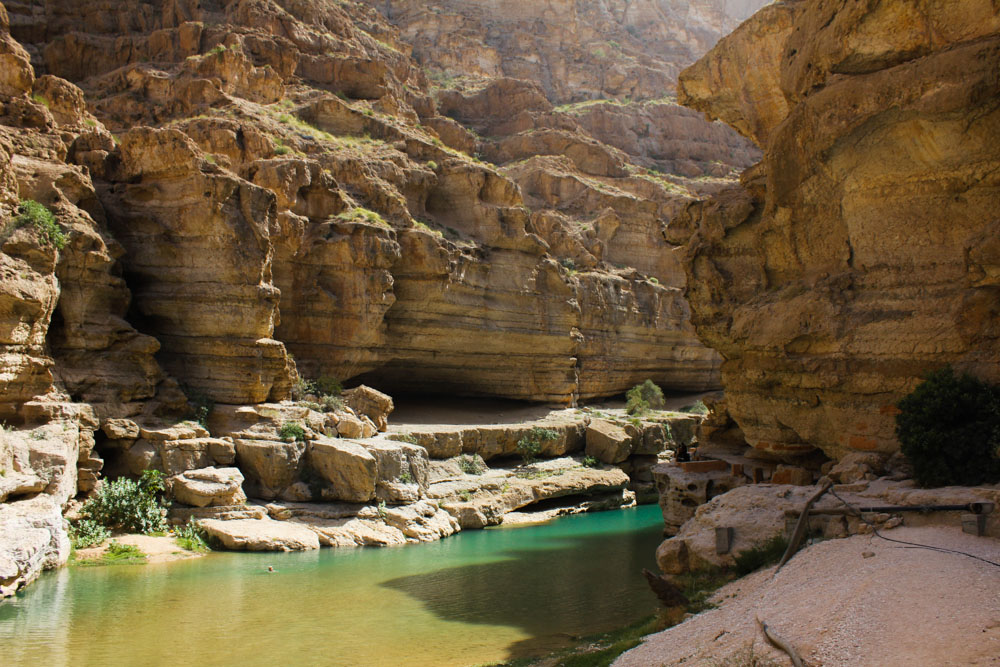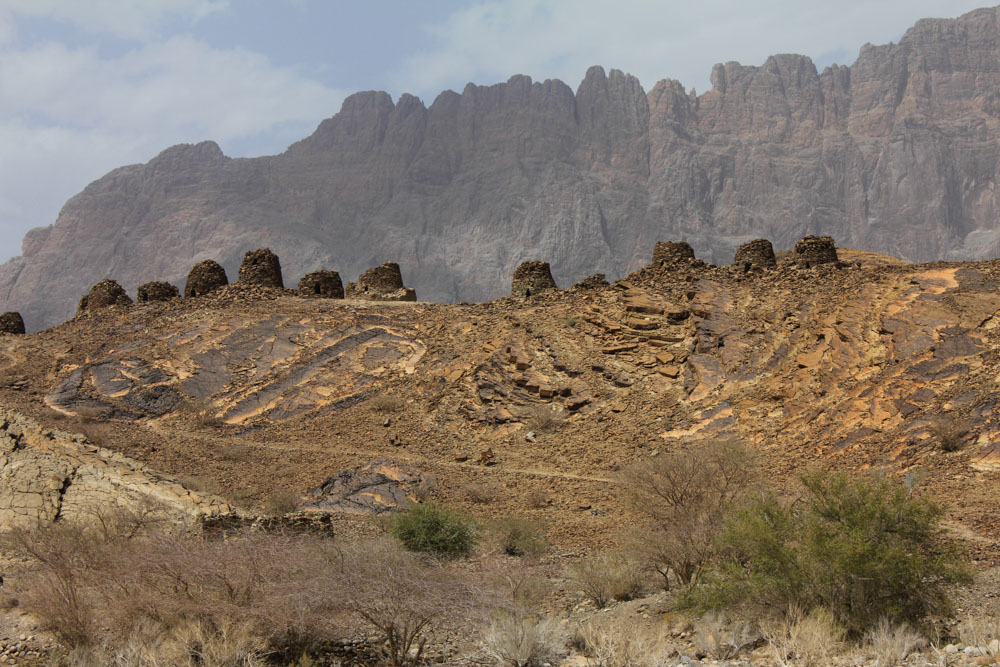Oman offers a diverse rage of attractions to the visitors: natural landscapes and ancient fortresses dominate the country, which can be easily explored in a week by a rental car.
Travelling to Oman by bus
Buses go from Dubai to Muscat twice a day, at 7 AM and 3 PM, from an unmarked bus station located in front of Oman Air’s small office. I could not find this information in any tourist guide however, I figured it out with the help of online forums.
First, I had to search for the roundabout with the large clock in Dubai’s Deira area, then the restaurant Caravan, which can be found a block away. The Oman Air office – which is the size of a newsstand – is located in this restaurant. I bought my ticket and I set out early in the morning. The bus was quite comfortable, it arrived on time and it had air condition. We underwent thorough border control, our luggage was even examined by sniffer dogs, but we managed to get through the administration part quickly.
The bus goes to Ruwi, but I convinced the driver to let me off at the airport, where I rented my car. It’s necessary to rent a car in Oman, as it is impossible to reach interesting sights by public transport. I had hesitated for a while as I thought it might be too risky to do a solo road trip as a woman in an Arabic country, but I heard so many nice things about the roads and hospitality in Oman, that I hoped for a safe journey. And it was indeed.
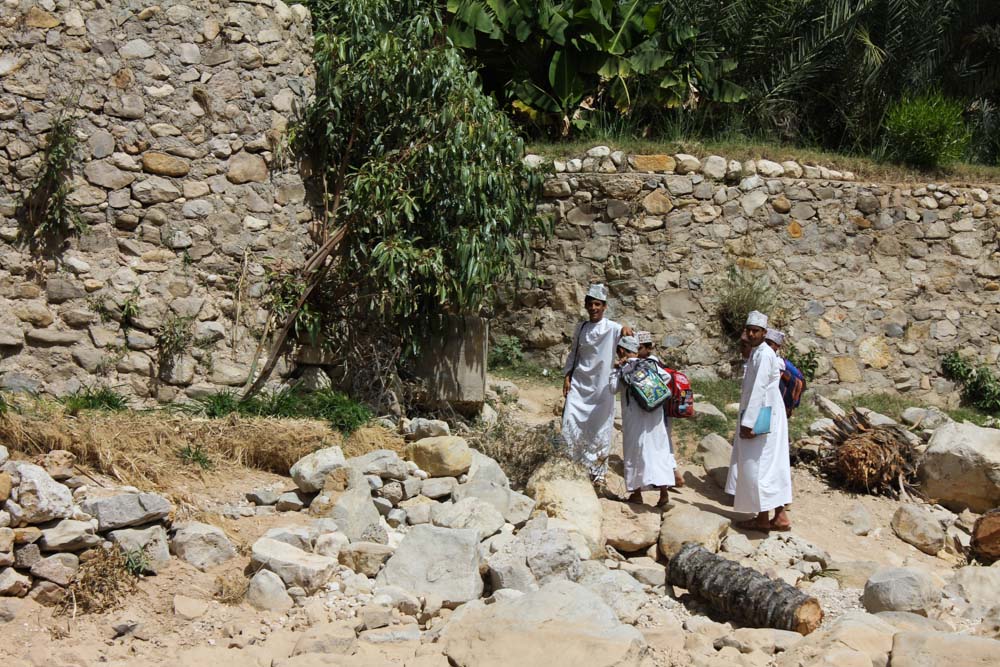
Renting a car
I was a bit shocked when I discovered that no car rental company offered GPS. I found the maps really lame, except the issue of Off-Road Oman, which is very useful for low category roads and dirt roads, but is of no help in cities or for motorways connecting them. I will ask for help, I thought. At that stage, I didn’t know that locals never admit if they don’t know the right directions. Instead they give you a confident, but mostly misleading answer.
In most cases, they orient towards peculiar buildings or roundabouts, but for first-timers it is not helpful to say “behind Hotel Tulip”. Overall, I didn’t get lost although I did have some detours. Without a map, GPS or other information, I could only rely on my unfailing woman’s intuition. Plus the price of gas is ridiculously low, so these random detours didn’t add much to the budget.
Wadi Shab
I headed to the southeast from the capital, in the direction of Sur. The brand new motorway goes through beautiful landscapes. In fact, it was so new that no gas station or buffet could be found nearby, so it’s worth setting out with a full tank and some food. I think the most exciting sights are wadis, the valleys lying between rocks in the desert, which are made by periodical water flows and which are easily negotiable in the dry season. Turquoise lakes and lush tropical plants reside in the barren rocks, and weary travelers can simply dip in one of these crystal clear lakes.
My first destination, Wadi Shab was one them. I went down the way, parked the car, crossed the stream with a small boat – there are always local young men, who are keen on taking you to the other side of the valley. The hiking trail starts here: on hot stones, under direct sunlight, between huge rocks.

I wanted to visit Wadi Tiwi on the same day, but I needed to drive a lot on smaller roads and it wasn’t possible with my car – even the travel guide says that it is only accessible with a four-wheel drive. I continued driving to Sur. Drivers are surprisingly polite and they immediately use their hazard lights if something is wrong – I really like this habit. For example, if someone uses the turn signal, the car behind him switches on the hazard lights immediately, so everyone can see that they need to slow down.
I easily found my accommodation, and, after a super quick check-in, I had dinner in a buffet near the gas station. Since I was there I decided to refuel, even though the tank was only half empty. At first I frowned at the fact that they didn’t accept credit cards, but it was really unnecessary: in the end I paid only 2.5 rials, which equals roughly 5 dollars. That’s crazy!
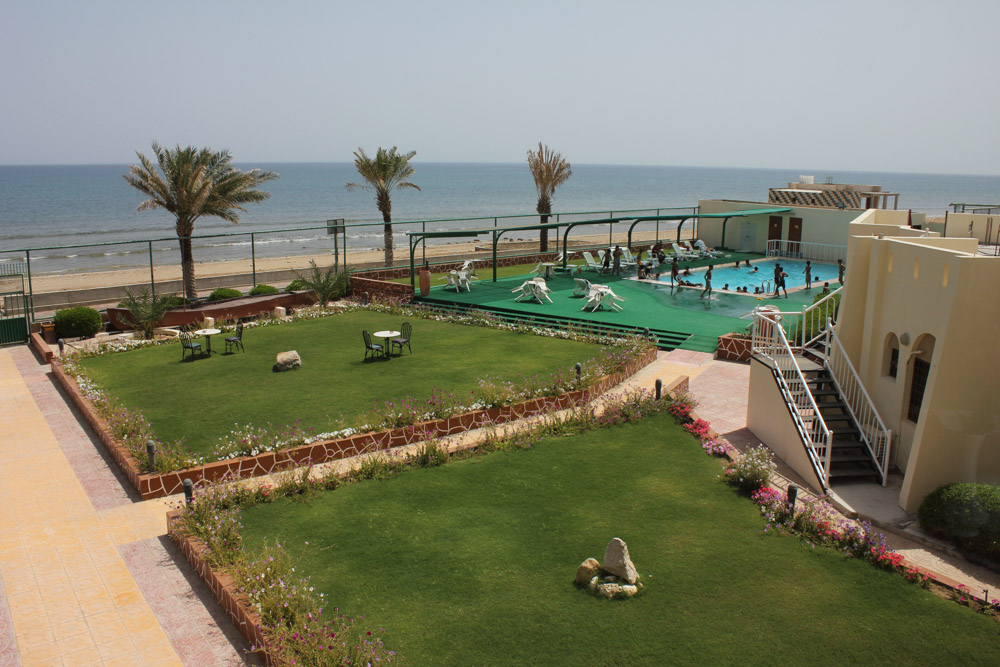
Bani Khalid instead of Turtle Reserve
The main attractions in the country’s northeastern corner are the turtle viewing tours at Ras Al Jinz Reserve. I booked an appointment but I really wasn’t sure if I wanted to participate. On one hand, it’s natural to be interested in watching turtles egg-laying on the beach, but on the other hand, we shouldn’t make such a business of it. The Reserve organizes walking tours every day at 9 PM for a maximum of 100 people, but as I read on the internet, most of them are really noisy and they take photos with flashlight. That would freak me out, not to mention the turtles. I have never had a birth experience, but I would not want to be enlightened with lamps and flashlights while giving birth. So I decided to miss this one out.
From Sur I headed to Nizwa, but I decided to visit another wadi, the beautiful Bani Khalid. Here you just walk on stones for hours and you see turquoise lakes appear in every corner – sometimes you need to cross them to proceed, sometimes you need to hold on to rocks along the bank. The landscape is atmospheric, even if the weather is inhumanly hot.
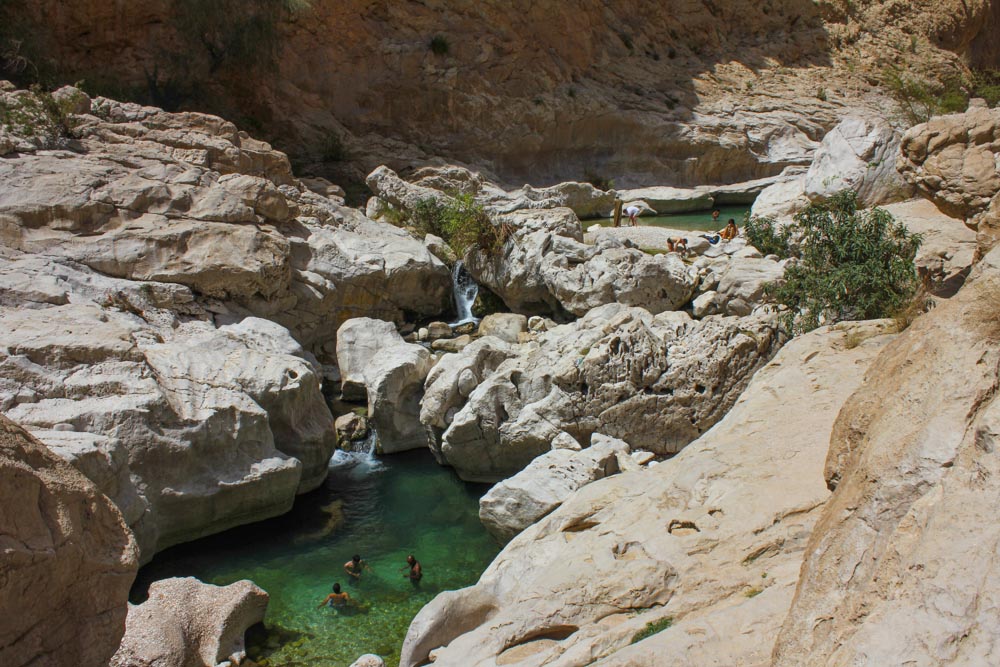
Nizwa
In Nizwa, I spent three nights in the Majan Guesthouse, which is a really austere guesthouse: I have never slept on such a firm mattress. Since I couldn’t use the air conditioner, I put my blanket under my bed sheet to soften it, so it didn’t feel completely like a prison bed. Unfortunately, this accommodation didn’t have a swimming pool, so I went to a five-star hotel’s pool for swimming and sunbathing, and no one ever stopped me while passing the reception to get to the sunbeds.
Oman is famous for its old fortresses. There are 500 of them in the country and some gorgeous ones are located in Nizwa and its surroundings. Bahla Fort is a UNESCO-listed world heritage site and it immediately got listed as endangered, because the storms destroyed its mud walls. Thanks to renovations, tourists can admire its original beauty – well, if it’s open at all, which is very rare. Unfortunately I also found it closed and I could only take pictures from the outside.
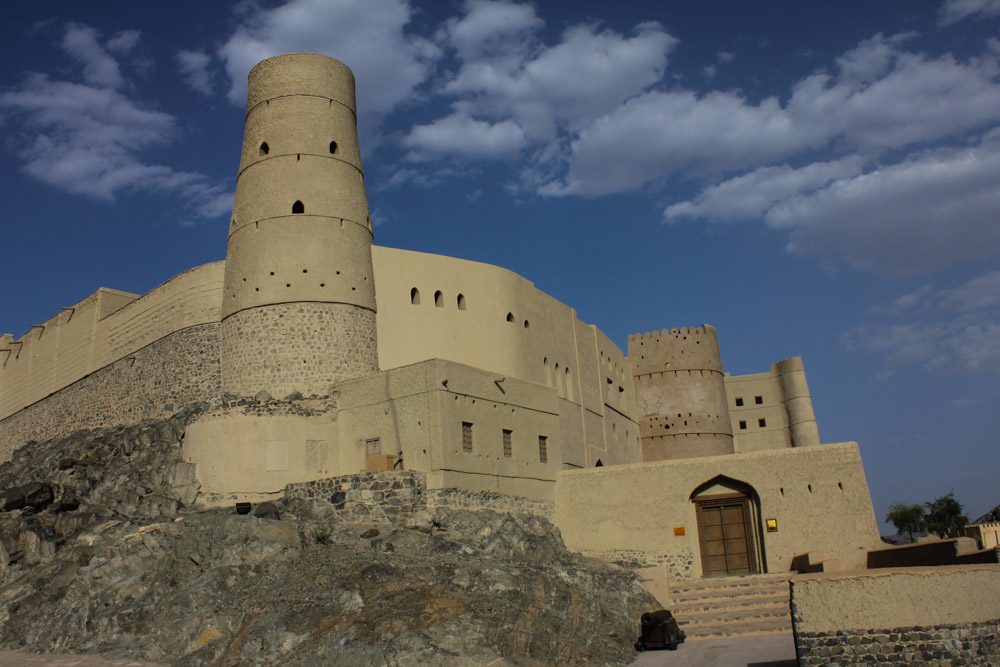
Jabrin Castle is also an enormous, magnificent building. Its interior has romantic zigzags and I got lost a few times, but I really enjoyed these ramblings. Some of the rooms had ceilings of impressive painted and carved timbers and I really liked the date stores, where they stack tons of dates which exude juice under their own weight. In peaceful times, this juice was used in the kitchen as palm oil, but during the war it was boiled and they threw it on the enemy. I climbed to the tower and from there I could see the whole area: the castle walls, the palm grove and the desert in the background.
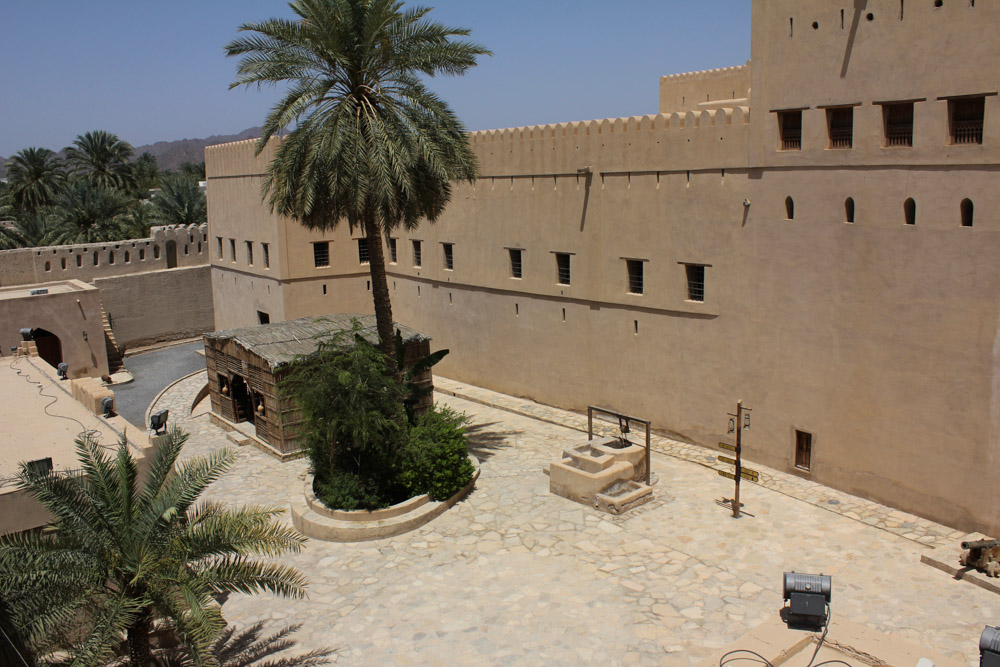
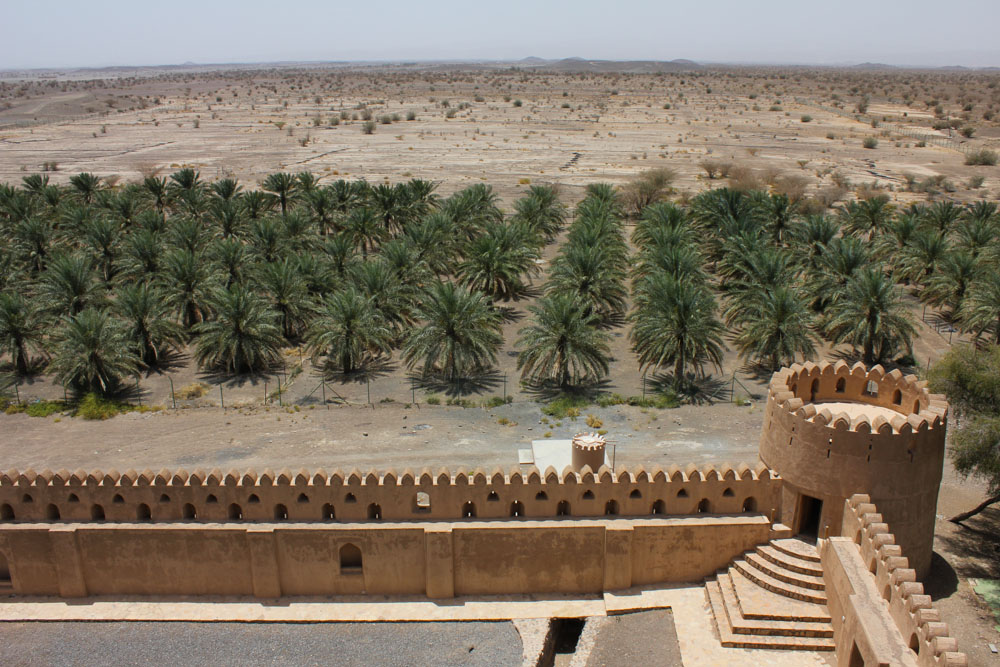
I was completely alone, apart from the ticket collector napping in the shadows. Of course, it was no surprise that in 40C degree heat, castles are not visited by crowds. The tourist season is between October and March, in April (the time of my visit) tourists are rare in Oman. In just a couple of weeks, the heat would be unbearable and then only places with air conditioning should be visited – by air-conditioned cars.
Falaj – the ancient irrigation system
It is worth visiting a small part of an ancient irrigation and drainage system (falaj) near Nizwa, which is also a world heritage site. The origins of falaj date back to 500 B.C., but some archeological finds suggest that drainage solutions already existed in 2500 B.C in this extremely dry area. The falaj system takes water out of underground springs, streams and lakes and sends it to villages and fields via a complex drainage system. They have strict rules for the usage of water – the day and duration of water usage is strictly controlled according to fair distribution.
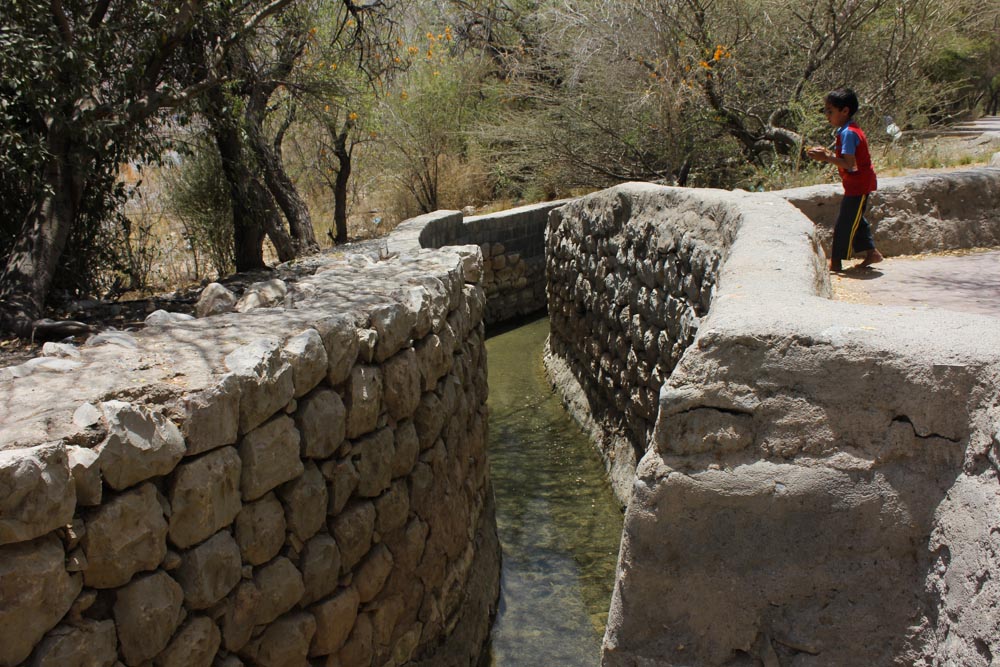
Regarding water usage, members of the community are dependent on each other, so everyone is led by common interest and values. The purpose of water usage is also strictly ruled: primarily it is for drinking, and then they allocate it to mosques and forts, then to public baths and what’s left is for washing and dishwashing. After that, date palms and other plantations get the water. The whole system is controlled by a deputy (wakil), whose tasks are the distribution of water, plus the budgeting and dispute settlement between users.
Along with wadis and fortresses, Oman attracts visitors with its desert dunes and mountains. I couldn’t risk an adventure in the desert with my car and I didn’t want to rent a land rover just for this trip, so I headed up the mountains only as far as my car could go. I headed to the country’s biggest mountain range, Jebel Shams, and the way up was incredibly beautiful. Unfortunately, I couldn’t go to Wadi Ghul, which is the local “Grand Canyon”, because the last few kilometers are via rocky, untarred roads with hairpin turns and it is recommended to only go there in a four-wheel drive. I thought it wasn’t worth the risk, as I had seen and captured enough beauty with my camera.
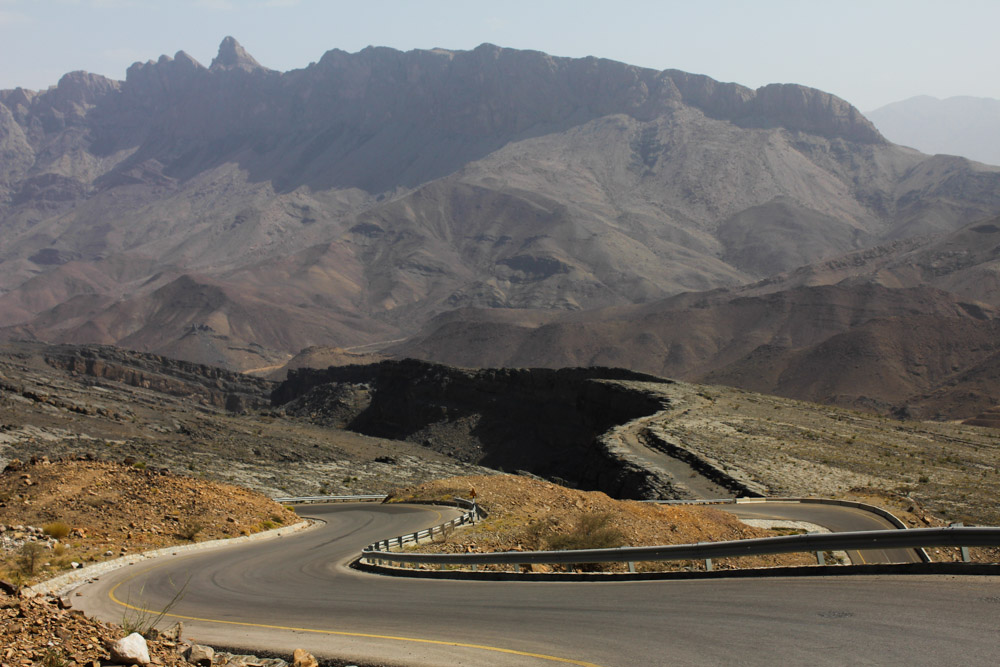
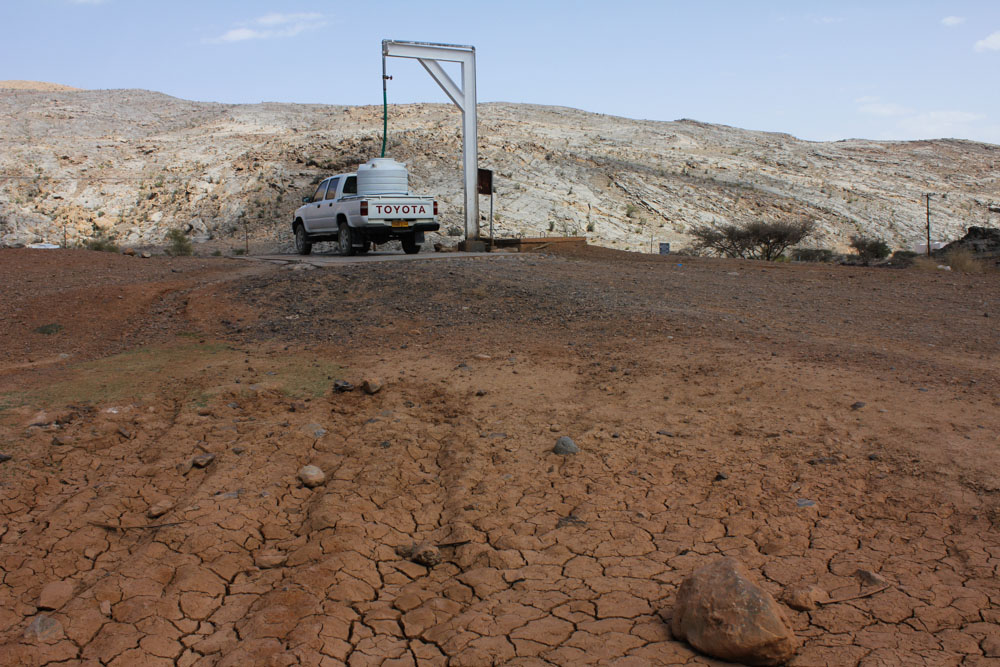
Al Ayn – graveyard from the Bronze Age
The graveyard of Al Ayn from the Bronze Age is also a world heritage site, and when I searched for the exact location on the internet, I found only a few comments from people who either could not find it, or found it with difficulty after detours. According to the Off-Road Oman map, an asphalt road leads to the area, so I was really hoping to find it. However, when I got to Al Ayn there no sign to direct me to the site. In the end, I stopped a car and its passengers were really helpful: they beckoned me to follow them and they led me to the foothills. From there, I could see the old, beehive-shaped graves.
I only needed to find the path over the dried-up river and then I was ready to approach it. Although the way itself is not long, it felt really long in 40 degrees – but it also felt amazing wandering alone among these 5000-year-old graves.
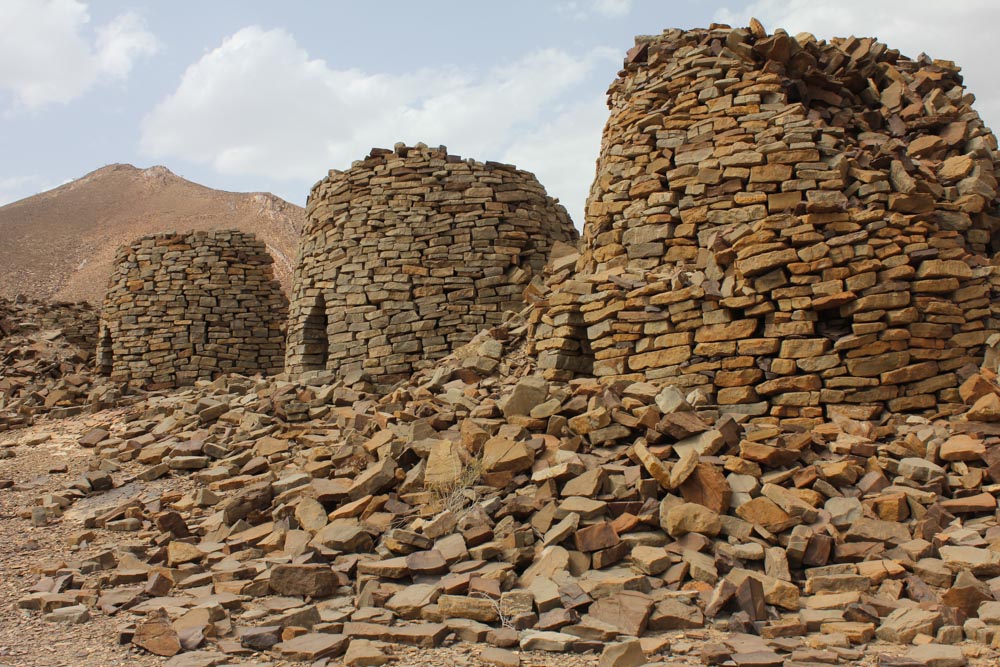
Muscat, Barka city and Narkhal Fort
At the end of my journey, I spent 2 days in the capital. I was particularly interested in the mosque, which lived up to its reputation and was really beautiful. However, after visiting the mosque in Abu Dhabi, it couldn’t totally win my heart. Of course, I also visited the Sultan’s Palace, which is surrounded by fascinating flower gardens. Muscat has so many flowers and trees that it could make several European cities envious of them.
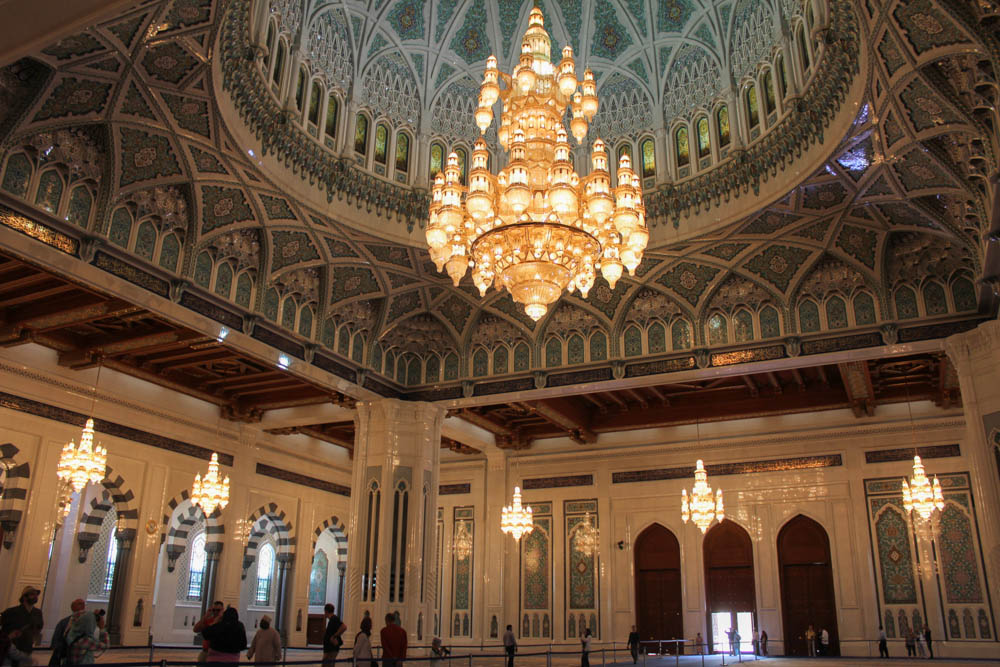
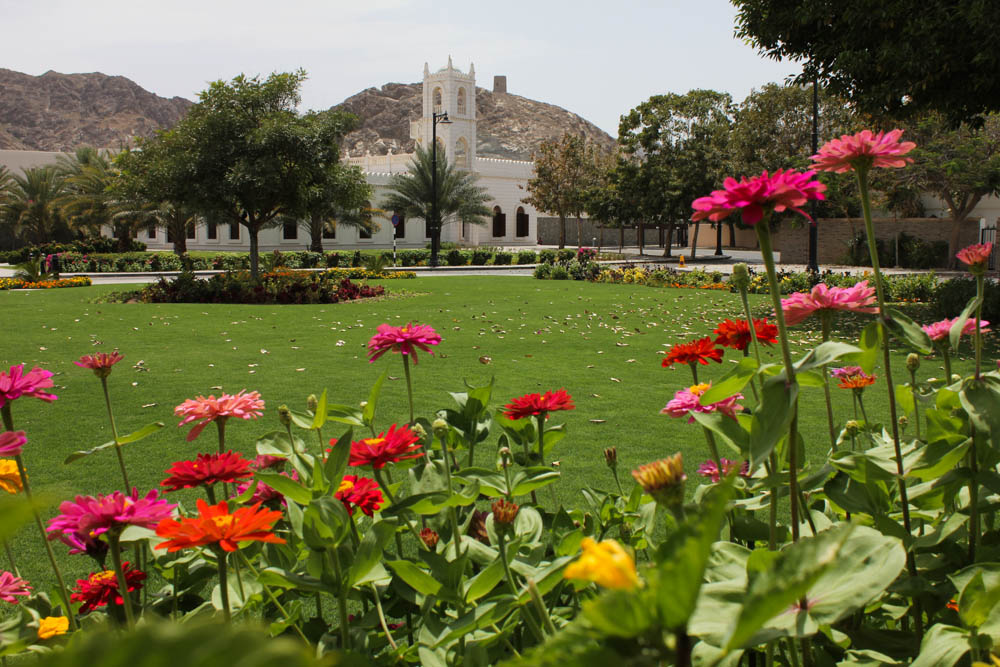
Next I headed to Barka city and Narkhal Fort which is on the coast. This is a really spectacular fort from the outside, especially as it is built on a rock, so the basement causes no trouble.
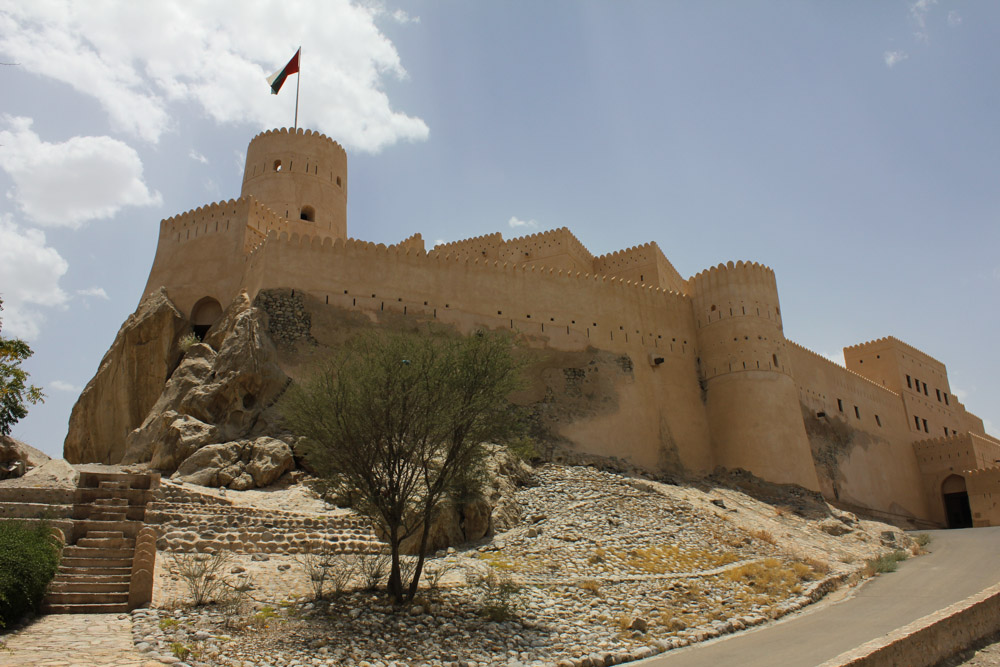
I had difficulty finding my hotel (Al Falaj Hotel), as it had only a very basic map on its website without the proper address. In the end I managed to find it and it was really worth the research, because this hotel cost only 36 OMR. It was an elegant four-star hotel with a swimming pool and three restaurants. I lounged at the swimming pool for the whole afternoon, as I too need to relax a little when on a holiday.
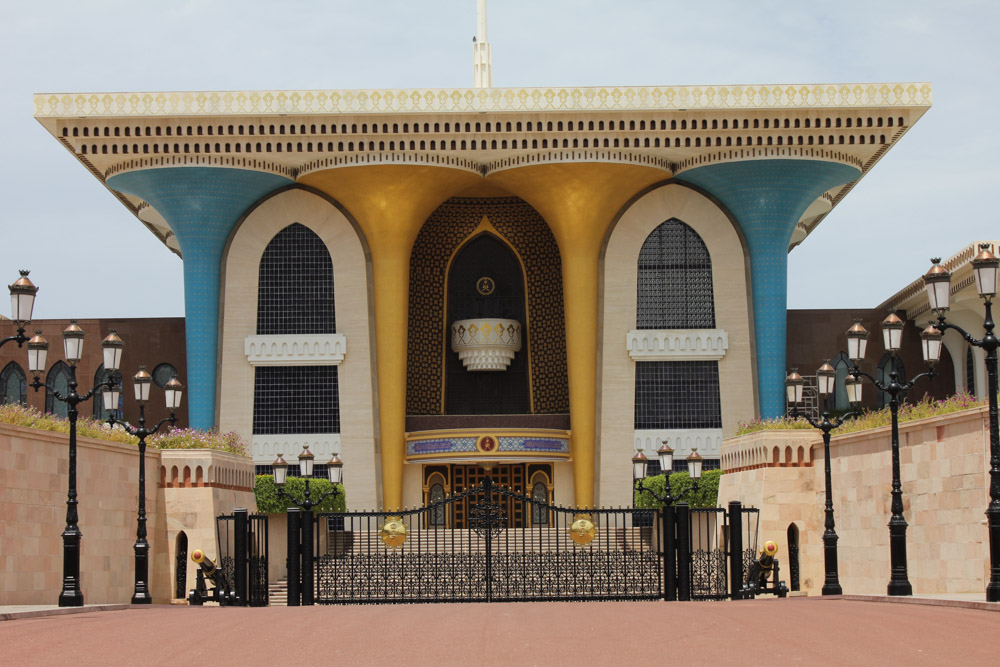
I returned my car late in the evening undamaged. I bought chocolates made of camel milk in the duty free – it is the most special snack here – and flew home.
During my one-week trip I never felt embarrassed or in danger, so in my opinion, anyone who likes to wander alone in this big world should definitely travel to Oman.

